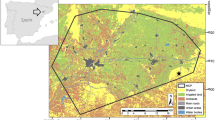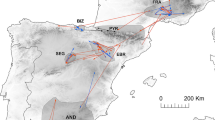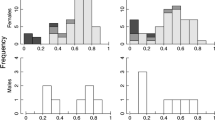Summary
The degree to which male sage grouse select lek sites and females select nesting sites to maximize proximity to the other sex was examined by contrasting male dispersions with the dispersions and movements of females in the months preceeding incubation. Wintering females exhibit highly overlapping ranges due to shared use of central refuging areas. In late winter and early spring, females move an average 9 km from wintering areas to select nest sites and males begin occupying leks. Pooled evidence suggests that females select nest sites independently of male dispersion whereas males adjust lek occupation so as to maximize proximity to females. Relevant observations include females visiting nest sites before leks, moving further to select a nest site than to select a lek, and increasing their distance to leks as a result of selecting nest sites. In addition, males avoid leks until females have moved to within 5 km of the arenas, abandon early season leks as local female densities drop, and exhibit dispersions in which mean ratios of females/male are similar across leks. Contrasts between predicted and observed dispersions of males showed that hotspot settlement models are adequate to explain male dispersions on very coarse scales (2 km or greater); on finer scales, habitat preferences of males and tendencies for males to cluster tightly must be invoked in addition to hotspots to explain specific lek sitings.
Similar content being viewed by others
References
Anderson JD (1982) The home range: a new nonparametric estimation technique. Ecology 63:103–112
Beehler BM, Foster MS (1988) Hotshots, hotspots, and female preference in the organization of lek mating systems. Am Nat 131:203–219
Berry JD, Eng RL (1985) Interseasonal movements and fidelity to seasonal use areas by female sage grouse. J Wildl Manag 49:237–240
Bradbury JW (1981) The evolution of leks. In: Alexander RD, Tinkle D (eds) Natural selection and social behavior. Chiron, New York, pp 138–169
Bradbury JW, Gibson RM (1983) Leks and mate choice. In: Bateson P (ed) Mate choice. Cambridge University Press, Cambridge, pp 109–138
Bradbury JW, Gibson RM, Tsai IM (1986) Hotspots and the evolution of leks. Anim Behav 34:1694–1709
Bradbury JW, Vehrencamp SL, Gibson RM (1989) Dispersion of displaying male sage grouse. I. Determinants of temporal variation. Behav Ecol Sociobiol 24:1–14
Braun CE, Beck TDI (1976) Effects of sagebrush control on distribution and abundance of sage grouse. Colorado Div Wildl, Fed Aid Wildl Rest Proj W37R, Work Plan 3, Job 8a, Final Report pp 21–84
Braun CE, Britt T, Wallestad RO (1977) Guidelines for maintenance of sage grouse habitats. Wildl Soc Bull 5:99–106
Dalke PD, Pyrah DB, Stanton DC, Crawford JE, Shlaterer EF (1963) Ecology, productivity, and management of sage grouse in Idaho. J Wildl Manag 27:811–841
Dunn PO, Braun CE (1985) Natal dispersal and lek fidelity in sage grouse. Auk 102:621–627
Eng RL (1955) A method for obtaining sage grouse age and sex ratios from wings. J Wildl Manag 19:267–272
Eng RL, Schladweiler P (1972) Sage grouse winter movements and habitat use in central Montana. J Wildl Manag 36:141–146
Giessen KM, Schoenberg TJ, Braun CE (1982) Methods for trapping sage grouse in Colorado. Wildl Soc Bull 10:224–231
Hamilton WD (1971) Geometry for the selfish herd. J Theor Biol 31:295–311
Klebenow DA (1969) Sage grouse nesting and brood habitat in Idaho. J Wildl Manag 33:649–662
May TA (1970) Effects of sagebrush control on distribution and abundance of sage grouse. Colorado Div Wildl, Job Compl Rep, Fed Aid Proj W37-R23, Work Plan 3, Job 3a, pp 115–138
Patterson RL (1952) The sage grouse in Wyoming. Sage Books, Denver
Petersen BE (1980) Breeding and nesting ecology of female sage grouse in North Park, Colorado. Unpublished Master of Science Thesis, Colorado State University, Fort Collins, Colorado
Poley B (1969) Effects of sagebrush control on distribution and abundance of sage grouse. Colorado Div Wildl, Job Compl Rep, Fed Aid Proj W27-R22, Work Plan 3, Job 8a, pp 61–86
Schoenberg TJ (1982) Sage grouse movements and habitat selection in North Park, Colorado. Unpublished Master of Science Thesis, Colorado State University, Fort Collins, Colorado
Wallestad RO, Pyrah D (1974) Movement and nesting of sage grouse hens in central Montana. J Wildl Manag 38:630–633
Woodward RH, Goldsmith PL (1964) Cumulative sum tests: theory and practice.ICI Monograph 3. Oliver and Boyd, Edinburgh
Zwickel FC, Carveth RG (1978) Desertion of nests by Blue grouse. Condor 80:109–111
Author information
Authors and Affiliations
Rights and permissions
About this article
Cite this article
Bradbury, J.W., Gibson, R.M., McCarthy, C.E. et al. Dispersion of displaying male sage grouse. Behav Ecol Sociobiol 24, 15–24 (1989). https://doi.org/10.1007/BF00300113
Received:
Accepted:
Issue Date:
DOI: https://doi.org/10.1007/BF00300113




